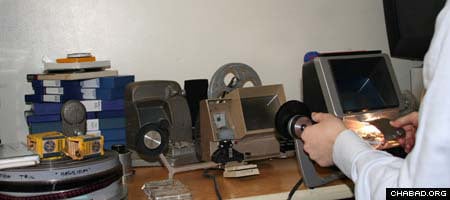The National Endowment for the Humanities awarded a grant to the group responsible for preserving the more than 4,000 hours of raw audio and video footage of the Rebbe, Rabbi Menachem Mendel Schneerson, of righteous memory.
According to Elkanah Shmotkin, director of Jewish Educational Media, the $5,000 allocation will help fund a study of the group's archives to assess how much its more than 1,600 recordings – some dating back to the 1920s – have decayed. The data will be used to determine how best to preserve the material, which was originally stored on quick-to-degrade magnetic tape.
The JEM collection contains film documents of Jewish life in the United States from as early as 1929, with particular emphasis on the talks and events surrounding the Rebbe. On an average day, a team of young Chabad-Lubavitch scholars clacks away from a Brooklyn, N.Y., office, adding subtitles in four different languages to the Rebbe's Yiddish talks for inclusion in the group's weekly "Living Torah" video compilation.
Digitizing the collection, however, has been an equally top priority. The tapes "are of serious interest to the general public," said Shmotkin, "and we owe it to history to preserve them."
Among the JEM collection are hours of footage of the Rebbe's historic meetings with world leaders. One well-known recording shows Israeli Prime Minister Menachem Begin consulting with the Rebbe in New York shortly before the 1978 Camp David Accords.
Jeffrey Shandler, a professor of Jewish studies at Rutgers University, said that "the case of Lubavitch film, video and audio, is one of the richest resources I have encountered."
Harvard University professor Ann Braude attached great importance to the preservation effort.
"For social and cultural historians, it is heartbreaking to find how few moving images have been systematically preserved," she said. "An archive like this is quite rare and needs to be preserved."
Consultant Steven Davidson's preliminary findings last year confirmed historians' fears: The data recorded on the miles of magnetic tape in JEM's vaults was in danger of being lost forever. He and JEM then embarked on a restoration project, dubbed "The Living Archive," which will see the footage systematically transferred to next-generation storage devices. The overall effort is expected to cost about $3.8 million.
In awarding the grant last month, the NEH recognized the value of the project.
"Scholars in religious studies and other types of cultural studies need access to this unique collection," a grant review panelist wrote. It "obviously could be utilized in many types of humanities and educational programming."
Shmotkin said that because of the basic filing system already in place at JEM, the job is probably less daunting than some at first feared, but no less urgent.
"I'm very hopeful," he surmised, "that the restoration project will be completed within the next two years."








Start a Discussion